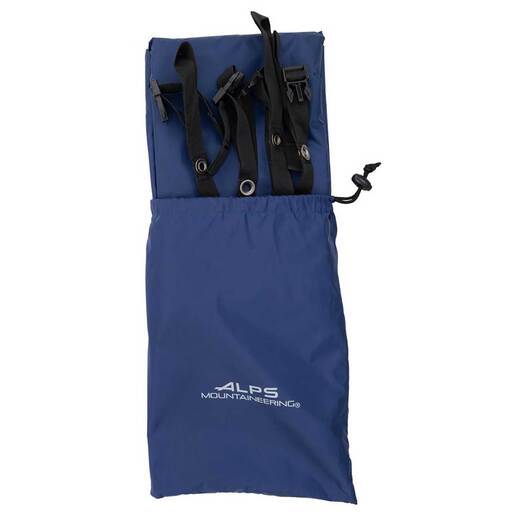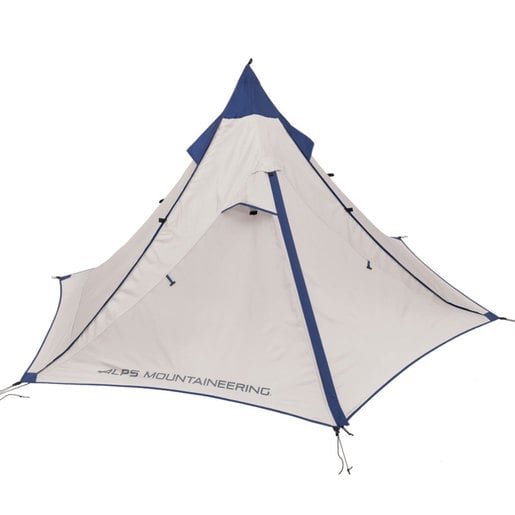The Alps Mountaineering Trail Tipi is a low-cost (MSRP $149), single-wall pyramid tent suitable for use by a single adult under 72″ in height or two youths up to 56″ in height. It has a trail weight (minus stakes and stuff sack) of 3 lbs 1 oz and requires a single trekking pole to set up. The tent has a single front door with a large vestibule, adjustable corner guy outs, two peak vents, 1 vestibule vent and a floating floor with 2″ of perimeter insect netting, like a tarp tent. While it’s not as buff as an ultralight backpacking pyramid costing 5-7 times as much, it’s perfectly suitable for campground or jamboree camping in good weather and is even lightweight enough for backpacking use.
Specs at a Glance
- Trail Weight: tent and pole jack (only) 3 lbs 1 oz / 1389 g
- Also included: 12 steel stakes, extra guylines, patch kit, stake sack (9.9 oz / 282 g) and tent sack (2.3 oz / 65 g)
- Trekking pole: Not included, height of 51-54″ recommended
- Seam-taped: Yes
- Minimum number of stakes to pitch: 6
- Vents: 3
- Doors: 1
- Materials: Fly is 75D 185T polyester with 1500 mm coating; Floor is Polyester taffeta with 3000 mm coating
Lightweight backpacking gear has gotten outrageously expensive these days, so I’ve been on the lookout for lower cost alternatives for my readers. The Alps Mountaineering Trail Tipi caught my eye because its outfitted like many ultralight pyramid tarps, but is made with heavier, more conventional fabrics to keep its price down.
Components

The Trail Tipi has a six-sided rain fly with a five sided internal floor that requires a single trekking pole, 51″-54″ in height to set up. The tent requires a minimum of 6 tent stakes to pitch. There’s one guyline for each “corner” that is connected to both the fly and the floor, so you tension both with a single stake. Line loc tensioners are included, which makes this a very simple process. When setting up the tent, you want to stake out all the corners loosely, insert the center pole and then walk around and tension the corners.

The peak is reinforced, but I still like to position the trekking pole handle up to prevent tearing it. A pole jack is included with the tent. This is a just a piece of plastic that fits over the other end of the pole to prevent damage to the tent floor. It’s very easy to loose, but you can replace it with anything from a piece of foam pad to a paper plate.

There’s a vestibule at the front of the tent, which closes with a two-way zipper so you can leave it partially unzipped for airflow. The zipper is positioned in the middle of the vestibule and there are door tiebacks on either side if you want to roll one open for the night. If you roll both doors open, I would recommend running an extra guyline from the peak for added stability because the tent will sag a bit if you remove the stake anchoring the door or one side of the vestibule. There are extra guy out points around the tent for this purpose.

The Trail Tipi also has three vents: two large vents in the peak and one in the vestibule. All three vents have insect netting behind them and kickstand vents to remain open. However, you still have to get out of the tent to adjust them if required.
Since this is a single wall tent, you want to maximize ventilation at night by keeping the front vestibule open and both peak vents as well. This helps prevent a temperature differential between the interior and exterior of the rain fly which is the cause of tent condensation. In addition to the mesh door, there is a 2″ band of insect netting between the walls and the floor for additional ventilation. It is covered by the rain fly so rain will not drip inside.
Living Space
The position of the pole is 22″ behind the front mesh door, which makes it hard to orient 2 people inside unless they’re quite short and both less than 56″ tall when lying down. There’s no way two adults can fit inside unless you stack them on top of one another.

Practically speaking, the tent will only fit one adult under 6′ in height or one adult and a dog, with plenty of interior space for gear storage. That adult can lie behind the pole on a diagonal. That’s how I’ve used it.

Being a pyramid, the tent ceiling slopes down which limits the amount of headroom at the sides. I’m 5′ 10″ and didn’t wake up with tent fabric in my face, but it’s nothing like the spacious interior of a dome-style tent in terms of ceiling height. If you want more headroom or living room in a pyramid tent, it helps to get one that has a much larger footprint and a higher center pole.
One of the interesting things about Tipi Tent is that it is configured as a single wall tent with a built-in floor. Most ultralight backpacking or conventional pyramid tents are floorless and have to be coupled with an inner net tent for insect or moisture protection (or used with a bivy sack). This can make them prohibitively expensive as well as heavy.
Assessment
While the Alps Mountaineering Trail Tipi has a pyramid shape, which is usually quite wind and weather worthy, the pitch is a little sloppy and the tent has a noticeable sag after 30 minutes despite its polyester rain fly. That coupled with the difficulty of fitting taller individuals makes me pause in recommending it for use except in good weather. If price is your main concern, I’d recommend picking up one of the 10 Best Budget Tents under $250 that we recommend, which include some low weight options and as well as models that can fit two adults quite comfortably.
Still, this Alps Mountaineering Trail Tipi Tent was definitely worth trying, if only to steer you to better alternatives.
Disclosure: The author owns this tent.
Compare 2 Prices
-

 Sportsman's Warehouse$34.99View
Sportsman's Warehouse$34.99View -

 Amazon US
Amazon US$139.99$124.99ViewAmazon.com Price: $124.99 (as of 04/16/2024 17:07 GMT-0400) Details
Product prices and availability are accurate as of the date/time indicated and are subject to change. Any price and availability information displayed on Amazon.com at the time of purchase will apply to the purchase of this product.
-

 Sportsman's Warehouse$139.99View
Sportsman's Warehouse$139.99View
 SectionHiker.com Backpacking Gear Reviews and FAQs
SectionHiker.com Backpacking Gear Reviews and FAQs 
Phil,
Thank you for being on the lookout for cost alternative equipment.
Lightweight equipment has gotten expensive so it is much appreciated.
I do believe in “buy once, cry once” in getting good gear. Would you apply this philosophy to your Big 3, or 4?
Keep up the great work
The hard part is in figuring out what the “best gear” for you is. Some people are perfectly content with gear that others would sneer at. But yes, if you’re going to spend more for good stuff, spend it on the heavier items in your pack that you take on every trip. Shelter, backpack, sleep insulation.
Just make sure your UL backpack is the last thing you upgrade, lest you end up trying to carry 40lbs of gear in a backpack that weighs 3 ounces and is made out of tissue paper.
Buying this through HikerDirect brought the cost closer to $80, so I almost “had to” get it. I agree with all your points. It may be an affordable intro to tipi/mid style tents, but there are more spacious options, and I’m not sure how well it would work for all but the smallest Scouts.
That’s a scouting discount program right?
Actually it will accommodate 2 6′ men and a dog. My son and I used this tent on my sheep hunt last year. Make sure you leave vents open. It was 21 degrees the first morning and we had a lot of ice to shake out of tent before finishing our trek to our final camp spot. Tent did it’s job for the weather we had.
I’m not 6 feet tall and my sleeping bag footbox was soaked because I was up against the side wall. Can’t imagine how you all fit. But there’s a will, there’s a way.
Bought this to go camping with my son and we found it to be a very tight fit, even though he’s only six. We upgraded to an REI dome after a frustrating 2 night trip where we had to climb all over each other to get out at night. This really isn’t a tent you want.